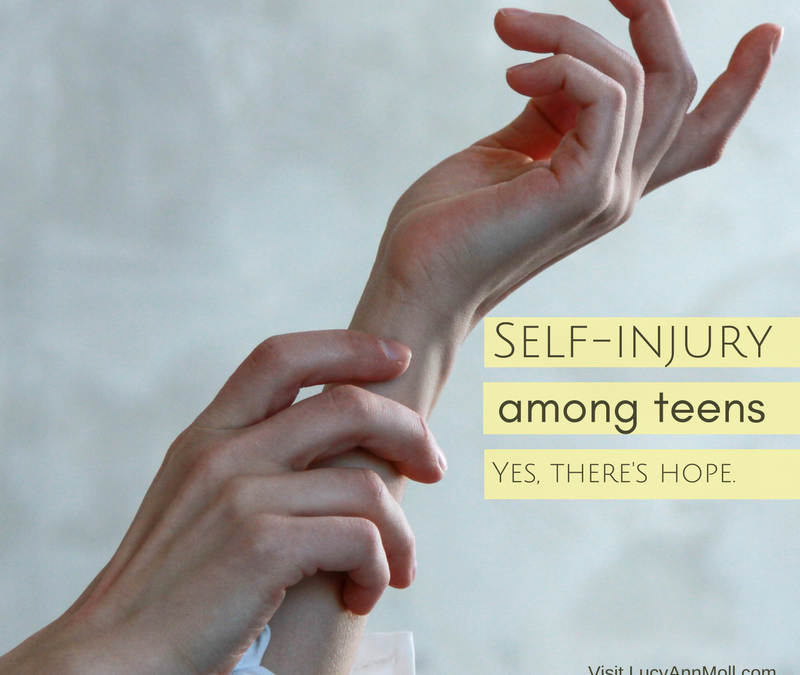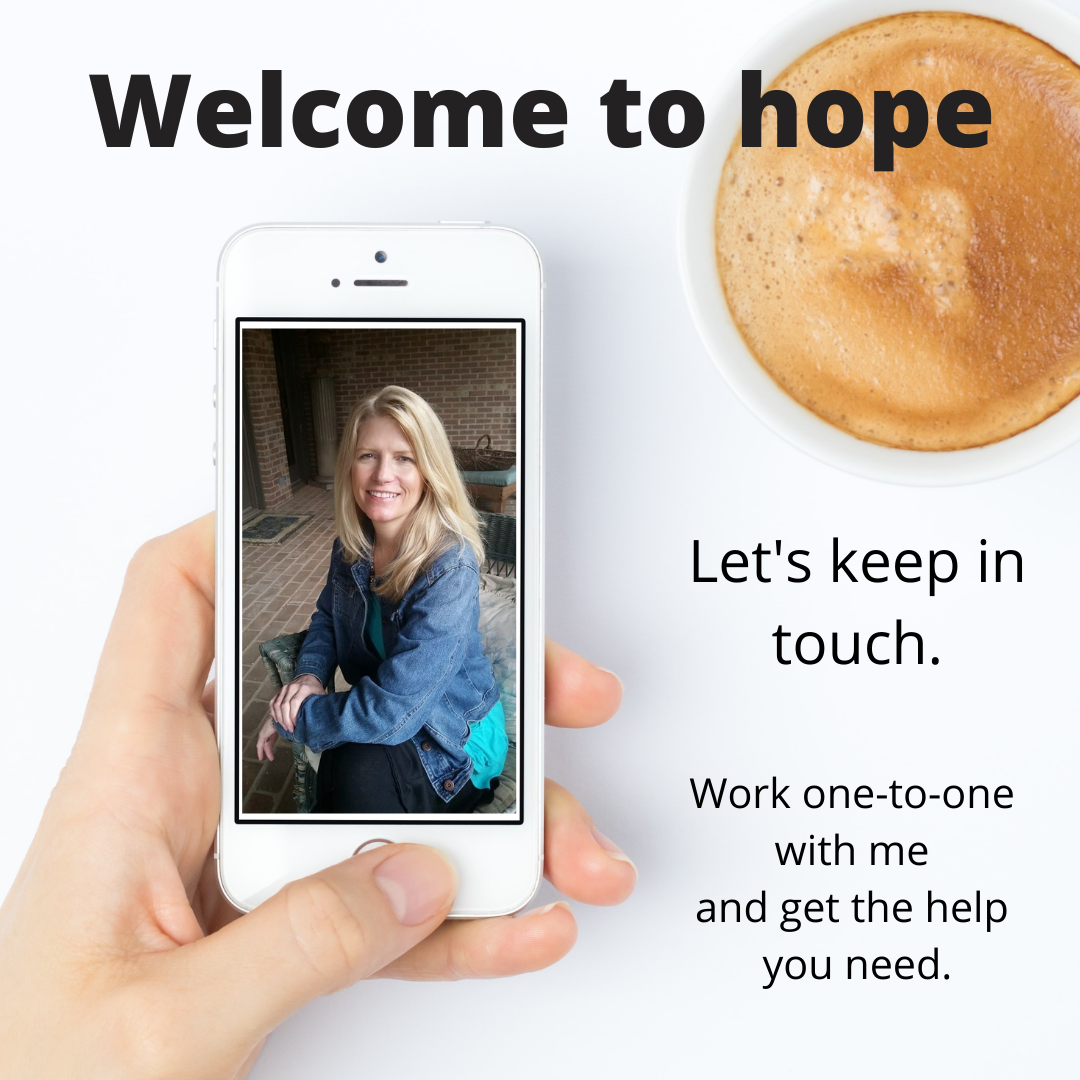
by Lucy | Apr 10, 2018 | biblical counseling, emotions, relationships
Self-Injury among teens (or anyone) doesn’t make sense, right? But for someone who self-harms, the act of cutting or burning (as well as other forms of mutilation) reduces emotional distress. And it has a root cause. This article by Julie Ganschow, who is listed on Heart2Heart Counselor Directory, first appeared here on The Biblical Counseling Coalition website and is used with permission.

Rebekka, 15, wore a hat, long sleeves, and jeans to our first counseling session. Not so unusual for a teen, except it was a hot August afternoon and the temperature outside was 101 degrees.
As I got to know Rebekka, I learned she was sent to see me because she was self-harming. She had no eyelashes or eyebrows, and her hat concealed large bald spots where she had pulled out her hair. I eventually saw the dozens of scars on her arms and up and down the length of her legs, where she had repeatedly cut herself and picked off the scabs. She also bore numerous burn marks from cigarettes and lighters.
Cutting and burning are the most common forms of self-injury among teens who we see in our counseling center.
Why Do Teens Self-Injure?
The teenage years (when self-injurious behaviors commonly begin) can be traumatic times. This can be especially in our culture, where children are presented with decisions and choices they are not mature enough to handle.
Our teens have greater pressures than at any time in history.
Click & Tweet!
College preparation now begins in eighth grade for many students, as they have to make choices about Advanced Placement classes. Many high school students work 20 or more hours per week to save for college. This is in addition to attending classes and doing AP homework.
At school, teens receive mixed messages about relationships and sexual orientation. Sexual behaviors are taught in graphic detail and promoted in the popular media. Our children are pressured to be sexually active long before they are emotionally and physically ready. They are thrust into many situations they are not ready to deal with! Some deal with the heartache of a broken home, spending alternate weekends with each parent, and the pressure that comes from being in the middle of divorce.
These are only the “normal” stresses and do not cover the extreme cases, such as sexual abuse by a parent or step parent; drug or alcohol use in the home by parents; out-of -control siblings who raise tension in the home; same-sex unions, sexually transmitted diseases or abortion.
Many children and teens come to believe there is little they can count on and nothing that is stable. Who can they talk to besides each other? Who can they really trust? All these factors feed into the world of self-injury among teens, and it becomes their method of dealing with indescribable pain and loneliness.
Like other self-injurers, Rebekka reported that she felt empty inside, stressed, and unable to express her feelings. She struggled to tell me she was lonely, not understood by others and fearful of intimate relationships and adult responsibilities. Self-injury was her way to cope with or relieve painful or hard-to-express feelings.
What Can I Do to Help?
There is no quick fix, no systematic formula to follow in stopping self-injury among teens. I encourage parents to follow biblical principles rather than going the route of psychotherapy and secular counseling. Secular reasoning is contrary to biblical methodology. The self-injurer doesn’t have an illness that can be medically diagnosed. Rather, she has is a faulty coping mechanism that has become a sinful habit.
Whenever possible, I involve the parents in the counseling process. We teach the parents how to disciple their child through this turbulent time in life. God entrusted Mom and Dad to care for their child and I am there to support them in teaching, rebuking, correcting, and training their child in righteousness (2 Timothy 3:16).
The biblical perspective on self-injury among teens is that it is primarily a heart issue (Matthew 15:11; Matthew 15:17-20; Luke 6:43). Like other self-injurers, Rebekka had an overall focus on herself: her pain, loss, feelings, her wants, and her desires.
She learned to examine her heart in light of Scripture (Jeremiah 17:9). The Bible reminds us that permanent change requires a change of heart brought about by a renewal of the mind (Romans 12:2). We had to identify the root cause of her behavior so true healing could take place.
Run to God with the Pain
I encouraged Rebekka to go to God in prayer and lay down the burdens of her heart.
The LORD hears the needy and does not despise his captive people (Psalm 69:33).
Directing Rebekka to the Psalms brought comfort and insight about crying out to God in distress. She was reminded that God cares about her, and the weight of guilt, shame, failure, anger, and rejection she carries. Also she was greatly comforted in realizing the Lord Jesus Christ was intimately acquainted with every sorrow and pain she had.
The Psalmist wrote,
Turn Yourself to me, and have mercy on me, For I am desolate and afflicted. The troubles of my heart have enlarged; Bring me out of my distresses! Look on my affliction and my pain, And forgive all my sins (Psalm 25:16-18, NKJV).
In biblical counseling, Rebekka learned the necessity of repentance. She learned about the sovereignty of God, people pleasing, and how to deal biblically with anger, hurt, and bitterness. As her mind was renewed, she began to understand the role idolatry played in her behaviors. She realized how worshipping her idols only led to guilt, shame, and deception and that, in reality, self-injury didn’t help with her pain after all.
Initially she experienced many failures and would still revert to cutting or burning herself, but Rebekka persevered in righteousness. She was determined to glorify God and worked very hard to stay in the Word, put the behavior off, renew her mind, and put on the new self (Ephesians 4:22-24).
She made life application of what she was learning and denied her fleshly desires. Six months later, she had eyebrows, eyelashes, and the bald spots on her head were covered with hair. The real triumph came when she gave her parents her “treasure box” of razor blades and burning materials.
Click & Tweet!
Today, Rebekka is free.
So if the Son sets you free, you are truly free (John 8:36, NLT).
Join the Conversation!
Do you believe the Word of God is enough to address even the “hard cases” in counseling?
Counseling Hearts to Hope,

by Lucy | Mar 22, 2018 | biblical counseling, Counselor Resources, emotions, thoughts
 Triggers: Often counselees speak of triggers, whether or not they have post-traumatic stress. It’s a societal buzzword. So what are triggers? How does the Bible term them? And what can you help your friend, counselee, or yourself handle them? The guest post by Andrea Lee whose article appeared first here on The Biblical Counseling Coalition website and is used with permission.
Triggers: Often counselees speak of triggers, whether or not they have post-traumatic stress. It’s a societal buzzword. So what are triggers? How does the Bible term them? And what can you help your friend, counselee, or yourself handle them? The guest post by Andrea Lee whose article appeared first here on The Biblical Counseling Coalition website and is used with permission.

As a biblical counselor, I often hear about “triggers.” These are situations, locations, words, and people that remind counselees of past pain or current heartache. These triggers threaten to engulf counselees in an avalanche of despair, anger, or anxiety. What is a trigger and how can a biblical counselor engage with people who seem to be subject to them?
Counselees view a trigger as an event or circumstance that is the cause of a particular response or emotional process
Click & Tweet!
. As a counselor to women, here are some situations I have encountered:
- It could be a mom who identifies her rambunctious toddler as a “trigger” – one energetic outburst and the mom is overwhelmed with exhaustion and despair.
- It could be a wife whose husband’s typical response in conflict is a “trigger”- one phrase or condescending look and the wife is flooded with anger or hopelessness.
- Or it could be a young single woman who sees Friday nights as a “trigger” – she has been alone and miserable for many Fridays and now dreads the end of every week.
In seeking to help these women, I explain to them that triggers do not cause their response. The so-called “trigger” is a reminder that tempts them toward a well-worn destructive thought pattern.
Click & Tweet!
The reminder is often associated with pain: previous failures, past hurts, or current broken relationships. Women feel helpless because they don’t know how to stop responding in a destructive way. I love to give hope by showing a new perspective on these moments.
When we label someone or something a “trigger,” we shift the place of emotional control from our own heart to an external object. The connection between event and emotion can mistakenly lead us to think the trigger is a cause. Actually, we have developed habits of thoughts in response to pain that continue to lead to these predictable emotional conditions. Our despair, anxiety, and anger reveal that we are ignoring God and disregarding His promises as we respond to the brokenness around us or in us. Instead of thinking in terms of triggers, I want counselees to see certain situations and people as cues – signals, prompts, and reminders – to begin a series of thoughts that are radically God-oriented. This shift in vocabulary begins to engage counselees in a process of repentance and trust when they are troubled by triggers.
Step 1: Recognize the triggers and the accompanying thinking
Women often know what launches them into a familiar path of pain. But here are questions that can help:
- What was the stimulus that began this descent into despair, anxiety, or anger?
- When do I have a disproportionate reaction to a situation or a person?
- Are others puzzled by the intensity of my response or mood swing?
Once the triggers are identified, it is vital to have the counselee write down their exact thoughts. You will probably hear some of these in the counseling room. For example:
- I can’t believe this is happening again. I can’t take it anymore. What if this never gets better?
- I’m stuck. Nothing ever changes. It’s unfixable. I’ll never change.
- Also I can’t breathe. I have to do something right now. I can’t stand the pressure.
If your trigger is related to an experience of sexual and/or physical abuse, please seek further help from a biblical counselor. You will also want to explore In the Aftermath, by Pam Gannon and Beverly Moore and Putting the Past in Its Place, by Steve Viars. If you are struggling with triggers associated with PTSD, Greg Gifford’s book, Helping Your Family Through PTSD, is a valuable resource.
Step 2: Repent by evaluating three categories
 God is gracious to help us identify triggers. It is a gift because it alerts us to repent in specific, concrete areas. Since repentance is the key to change, this gives us hope.[1] Repetitive elements in the counselee’s thinking will reveal weaknesses in theology and worship. Counselees often minimize or ignore God’s goodness, God’s presence, and God’s perfect ways.
God is gracious to help us identify triggers. It is a gift because it alerts us to repent in specific, concrete areas. Since repentance is the key to change, this gives us hope.[1] Repetitive elements in the counselee’s thinking will reveal weaknesses in theology and worship. Counselees often minimize or ignore God’s goodness, God’s presence, and God’s perfect ways.
Psalm 40:1-3 is a great passage to address these areas of unbelief.
- God IS good: “As for you, O Lord, you will not restrain your mercy from me; your steadfast love and your faithfulness will ever preserve me!”
- God IS present: “As for me, I am poor and needy, but the Lord takes thought for me. You are my help and my deliverer; do not delay, O my God!”
- And God IS working: “He inclined to me and heard my cry. He drew me up from the pit of destruction…He put a new song in my mouth”
The Psalmist doesn’t believe these things because he has a perfect past or a blameless record (see Psa. 40:12), but because God gives salvation out of His great mercy in Jesus Christ.
A prayer of repentance may sound something like this:
- Lord, this thought process reveals that I am not believing the truth about who you are. Please forgive me for going astray after a lie (Ps. 40:4).
- My thinking has become futile because I am not honoring you or thanking you (Rom. 1:21).
- I am in a pit of destruction and a miry bog of my own making when I continue to think hopeless, godless thoughts (Ps 40:2-3).
- Instead of spinning into despair and anxiety, help me to wait patiently for you and keep crying out to you. Thank you for your forgiveness and help.
Step 3: Mobilize your cue
Finally, help counselees prepare specific thoughts they will embrace the next time a trigger comes. Identify one thought that most fuels the downward cycle and prepare a God-honoring thought that will replace it. Develop simple statements that can be easily memorized and repeated. When they experience a trigger, the counselee should:
-
Engage in gratitude:
- Thank God for this opportunity to worship Him and to be changed.
- Thank Him for the reminder that we all need a Savior and God has provided one.
- And thank God for the reminder of past sin or hurt because it humbles us and pushes us to know Christ better
-
Embrace a promise:
- God’s grace is up to the challenge.[2]
- God will give me all the grace and strength I need to obey Him (1 Cor. 10:13, 2 Cor. 9:8).
- Also God hears my cries; He is working and He is good (Ps. 40).
There is great joy and hope in moving from trigger to cue by specific repentance and obedience. As you help counselees to recognize, repent, and then prepare for specific situations, you are equipping them to worship God and love others with greater wisdom and diligence. Painful reminders in life can be a cue to trust God by remembering and rehearsing His goodness, His presence, and His perfect ways.
Questions for Reflection
What triggers trouble your counselees? What thoughts fuel the negative spiral? And what cues have you mobilized in your counseling that have been particularly effective?
[1] Heath Lambert, “Die to Self and Grow in Love,” (presentation, Association of Certified Biblical Counselors Annual Conference, 2013; https://biblicalcounseling.com/product/die-to-self-and-grow-in-love-heath-lambert-2/)
[2] Kevin Carson, “Five Favorite Passages in Biblical Counseling” (presentation, Biblical Counseling and Discipleship Training, Atlanta, GA, Jan. 27, 2018).

About Andrea Lee
Andrea Lee lives in Atlanta, Georgia with her husband of 11 years. She serves women in the church and community as a biblical counselor.
Counselor, would you like to join Heart2Heart Counselor Directory too? Choose a free listing (or an upgrade). Make connections with like-minded counselors and new counselees. Learn more.
Counseling Hearts to Hope,
by Lucy | Mar 13, 2018 | biblical counseling, emotions, thoughts
 OCD. . .Can biblical counselors help people who suffer from obsessive-compulsive disorder? Find out as you read this article that appeared first here at The Biblical Counseling Coalition.
OCD. . .Can biblical counselors help people who suffer from obsessive-compulsive disorder? Find out as you read this article that appeared first here at The Biblical Counseling Coalition.

Glenna[i] twists a Kleenex in her hands and looks out the window of the counseling office. The Crayola-blue sky belies the storm within her. “I have these awful images,” she whispers. “I see children and they’re being hurt.” Her voice breaks off. “What kind of person am I? If I have these disgusting thoughts, then I, I must like them, right? There’s something terribly wrong with me.”
A Christ follower in her early-30s, Glenna shows telltale signs of Obsessive- Compulsive Disorder (OCD). In a few words, OCD is an anxiety problem characterized by recurrent, intrusive thoughts (termed obsessions) and repetitive behaviors (called compulsions). OCD is a label used among psychotherapists; no equivalent term appears in Scripture.
First, let’s look at a secular understanding of OCD. Then we’ll look at a biblical view and approach. You’ll also hear a bit about brain research showing a physiological component of OCD.
Secular Take on OCD
The Diagnostic and Statistical Manual of Mental Disorders (DSM) describes the behaviors associated with OCD and lists it as a common disorder affecting one in 50 people worldwide. It also describes four major types of obsessions: contaminations, aggressive impulses, sexual content, and the need for symmetry.
In response to an obsession, a person with OCD typically feels compelled to ease their anxiety through performing a compulsion. Common compulsions include:
- Excessive cleaning and/or hand washing.
- Arranging and ordering items in a particular, precise way.
- Repeatedly checking on things, such as repeatedly checking to see if the door is locked or that the oven is off.
- Counting and/or making sure numbers end on a “good” digit.
Like obsessions, compulsions are unwanted — and they are exhausting. But to not perform them is even worse. “Their anxiety goes off the chart,” says biblical counselor Elyse Fitzpatrick.[ii]
Psychologists typically prescribe an SSRI to help OCD sufferers. However, 30 percent of those treated don’t improve.[iii]And among those who do respond, when the pills stop, the symptoms return. This is why doctors often recommend Cognitive Behavioral Therapy(CBT).
Physiological Component of OCD
OCD has a strong physiological basis. Among the scientific evidence are twin and family studies that show people with first-degree relatives (such as a parent, sibling, or child) who have OCD are at a higher risk for developing OCD themselves. But the most important physical component is the brain itself. By using Positron Emission Tomography (PET), researchers have discovered intriguing differences between the brains of people with OCD and other people. Says leading researcher Dr. Jeffery Schwartz,
The problem is a faulty brain circuit in OCD sufferers.
Click & Tweet!
Also, it appears that the physiological problem may be a malfunction in a brain structure called the caudate nucleus. This structure is like a processing center for complicated messages generated by the front part of the brain. The caudate nucleus and the putamen, which lies next to it, take in messages and function in unison, smoothing transition from one behavior to another. Typically, a person makes many rapid shifts of thoughts and behavior, smoothly and easily, and usually without thinking about them.
But in OCD, the problem may be that the smooth shifting of thoughts and behavior are disrupted by a glitch in the caudate nucleus. This may cause the frontal lobe to become overactive.
Think of a car stuck in a ditch. The wheels spin and spin but the car goes nowhere without traction. With OCD, too much energy is being used in a frontal part of the brain called the cerebral cortex. It seems that due to malfunction in the caudate nucleus and other brain structures, OCD sufferers might be flooded with, and act on, thoughts and impulses that enter their mind.
A Biblical Approach to Helping OCD Sufferers
To help OCD sufferers, biblical counselors John and Janie Street, authors of The Biblical Counseling Guide for Women, developed a biblical method based on Schwartz’ four steps described in his book Brain Lock. His research shows before-and-after PET scans of actual change in the brain. Streets’ method focuses on biblical renewal of one’s thoughts. Below are two of the foundational verses they utilize:
“Do not be conformed to the pattern of this world but be transformed by the renewal of your mind, that by testing you may discern what is the will of God, what is good and acceptable and perfect” (Rom. 12:2).
“…put off your old self, which belongs to your former manner of life and is corrupt through deceitful desires, and to be renewed in the spirit of your minds, and to put on the new self, created after the likeness of God in true righteousness and holiness” (Eph. 4:22-24).
The 4 Steps
The Streets suggest these four steps for OCD sufferers:
- Repent: Identify and confess all obsessive thoughts that control you because they sinfully presume your ability to live by rigid rules of thoughts and behaviors, supposedly filling you with peace and joy (Rom 14:17, 1 John 1:9-10).
- Re-label: These recurring thoughts and behaviors are anxious and fearful. They are the source of your sinful fear. Choose to fear God only (Psa. 34:9, Prov. 1:7, 2 Cor. 5:9).
- Replace: Substitute anxious thoughts with thinking that fully trusts a good and loving God.
Click & Tweet!
You may also choose to hold and look at a happy photo, adding both visual and tactile senses to thinking (Psa. 18:2, 2 Cor. 4:5, 1 Tim. 6:15).
- Re-focus: Devote yourself to loving God and loving others. Do not remain self-focused (Matt 22:36-40, James 2:8, 1 John 4:18).
As Glenna applied these four steps to her own obsessive thoughts, she experienced improvement almost immediately. The thoughts reduced in frequency and intensity. However, when under stress, she sometimes failed to repent, re-label, replace, and refocus. But the hope is, as she perseveres, her brain might change just as the ones in Schwartz’ PET scans changed. In the past few decades, brain science is finally recognizing what the Bible has said for millennia. That is, the renewing of one’s thoughts can create real, measurable, and observable changes in the brain.
OCD is a horrible lot. This is true. Indeed, ever since the Fall (Gen. 3), our brains have been compromised. And the good news is God can restore the fallen brain in people like Glenna, who now has hope.
Questions for Reflection
What approach have you taken with counselees who have obsessions and compulsions? And what was the outcome? How are you becoming more knowledgeable about brain science that supports the truths of the Bible?
[i] Glenna’s name and some details have been changed.
[ii] Elyse Fitzpatrick, podcast, “The Far Side of Fear,” https://ibce.org/ocd-the-far-side-of-fear/
[iii] Janet Singer, “ERP Therapy: A Good Choice for Treating Obsession-Compulsive Disorder,” MentalHealth.Net. https://www.mentalhelp.net/blogs/erp-therapy-a-good-choice-for-treating-obsessive-compulsive-disorder-ocd/
by Lucy | Jan 2, 2018 | biblical counseling, emotions, whole health wellness
 Who doesn’t need a mood-boost? A routine prescription for women with depression and anxiety is exercise. Regular physical activity of any sort can lift sagging spirits.
Who doesn’t need a mood-boost? A routine prescription for women with depression and anxiety is exercise. Regular physical activity of any sort can lift sagging spirits.
A glad heart makes a cheerful face, but by sorrow of heart the spirit is crushed. Proverbs 15:13, ESV
Even Exercise-Lite Boosts Your Mood
At the Cooper Aerobics Research Institute, 120 volunteers followed the standard gym recommendations and another 120 volunteers tried exercise-lite. Both groups on average reduced their blood pressure by eight points, lowered total cholesterol, and gained about the same amount of muscle and dropped about the same amount of fat.
What about boosting endorphins while exercising-lite? They got that too.
But for a bigt boost, it seems you must stress muscles for the release of the endorphins. Remember, you don’t have to train for the Olympics to get a mood boost from exercise.
Click & Tweet!
So get up and get moving.
And break a sweat! A shiny glow looks good on you.
Click & Tweet!
Pick an exercise you like! For me, walking wins. Early in the day, I grab my sneakers and walk. In the evening, I stretch and do some simple exercises like push-ups. Once you figure out which exercise works best for you, make a plan and do it.
Making a New Mood-Boost Habit
Making a new habit and sticking with it is the most difficult part for most of us because new habits must be formed. Beth, a soft-spoken, 20-something who has mild anxiety, would like to lose five pounds and feel physically better.
Then I told her about the mood-boosting effects of exercise, and she said she’d start for sure. Awareness is the first step, isn’t it?
What’s next? Here are 3 quick tips toward making a new mood-boost habit:
1. Put it on your calendar. You write “dentist visit” on your calendar, don’t you? So why schedule exercise? Be specific. Select a time, days, and place.
2. Be realistic. Be safe. Most people the greatest success in forming a new exercise habit when they build on beginning successes. If you choose walking and are a healthy beginner, start with a daily 10-minute walk at a moderate pace, for instance. The next week add 5 minutes to your daily walk. Add another 5 minutes the following week and so on. Once you reach 30 to 60 minutes of walking daily, you’ve developed an amazing mood-boost habit. (Check with your doctor before beginning an exercise program.)
3. Reward yourself. Each time you complete your exercise, give yourself a small reward. It could be as simple as a smiley face on your calendar to something a bit more extravagant, such as $5 toward a purchase. At the end of the week, grab your stash and go for lunch with a friend, take in a movie, or buy something fun.
Counseling Hearts to Hope,

by Lucy | Dec 28, 2017 | emotions, relationships
 Perfectionism is an impossible standard! For you and me, that is. God is perfectly perfect!
Perfectionism is an impossible standard! For you and me, that is. God is perfectly perfect!
But to attain perfectionism, you may drive yourself nuts. Or you may face-plant into the wall of “I cannot do it” and give up and retreat. You may even find a frenemy in dark chocolate. This is my go-to happy place. What’s yours?
Click & Tweet!
Either way, all-or-nothing thinking turns into anxiety, even anger and hopelessness.
Jana, a mother of three boys and a nurse, worked part-time in the evening, and during the day she had the family on a tight schedule in order to get everything done: piano lessons and soccer practice for the kids and a book club and Zumba for her. When her all-or-nothing thinking turned into yelling–something she swore she’d never do when she became a mom–she didn’t see that her perfectionism played into the family tension. A wise counselor compassionately and truthfully pointed it out, and she agreed her heart needed to change.
Have you ever wanted to do it all or think you should do it all?
Click & Tweet!
Have you based your worth and success on how well you measure up to your standards or fulfilling your expectations?
- When you are driven to achieve and overdo, you live in fear that there is always something more you can do, another phone call to make, another website to check, another friend to check in on.
- When you hold exceptionally high expectations for yourself (or your family or coworkers), you may come across as pushy and demanding. Your relationships may suffer.
- When you compare your accomplishments to others, you may feel defeated and get grumpy or throw a pity party. No one shows up to pity parties. Too depressing!
Signs of Perfectionism
The all-or-nothing thinking of perfectionism overwhelms a person because, as I mentioned up top, it’s a myth. No one is perfect but God!
“Your heavenly Father is perfect.” Matthew 5:48, ESV
Very often someone with all-or-nothing thinking suffers from anger, anxiety, depression, or fatigue. Trying to keep up with overwhelming perfectionism is daunting. You just can’t do it. No one can. That you cannot be perfect doesn’t mean you are “less than” or “not enough.” It simply means you’re human.
Here are pictures of three signs of perfectionism.
Anger: When your perfect plans fall though, do you seethe or feel irritated? Do you lash out at a friend or family member? A common result: difficult relationships! Think about it. You don’t like anger directed at you and you may step away from an angry person or not return her phone calls. Proverbs 15:1 says,
A soft answer turns away wrath, but a harsh word stirs up anger.
Anxiety: Do you feel uptight and nervous when you think about all you need to do? Do you worry that you’ll fail? Sometimes anxious people have physical symptoms such as nausea, insomnia, headaches, and fatigue, even panic attacks. Others develop ulcers. Talk with your medical doctor about physical manifestations of anxiety.
Depression: Do your unmet desires lead to sadness and self-recriminations? Are you disappointed with yourself that you failed to meet your high expectations? Do you say mean things to yourself, like “I’m a loser”? Depression feels like sadness, despair, hopelessness. Sometimes it has an organic cause, such as hormone imbalance. Again, talk with your medical doctor about physical causes of depression.
Out of the Perfectionism Trap
Your way out of perfectionism is to make a heart change and to look to your Creator for the answer.
Click & Tweet!
Here are 3 ways to end perfectionism:
Click & Tweet!
1. Accept the invitation to rest.
May I suggest that you write the verse below in a journal or your electronic device and read it daily?
Come to me, all who labor and are heavy laden, and I will give you rest.
Take my yoke upon you, and learn from me,
for I am gentle and lowly in heart, and you will find rest for your souls.
For my yoke is easy, and my burden is light. Matthew 11:28-30, ESV
When you get to the end of your abilities and energy, you need rest. Your mind and your body. You feel depleted and weary. The question is, how will you respond to this invitation? Do you value yourself and your family enough to rest?
2. Ask yourself a few questions.
To get to the heart of your perfectionism, ask yourself questions and jot down your answers. Ask yourself:
- Who am I trying to please? My boss, my friends, my parents, myself, God?
- Is my all-or-nothing thinking all about getting other people to accept me or to impress them?
- Do I think I can do life without God? That I don’t need him?
Now read your answers and look for a pattern. Is your pattern to please others or to get attention? Do you see another pattern? How can you change your thinking so that your thougts align with God’s?
3. Love God above all else.
You’re probably familiar with the Great Commandment.
You shall love the Lord your God with all your heart and with all your soul and with all your strength and with all your mind, and your neighbor as yourself. Luke 10:27, ESV
When you love God above all else, your priorities and motivations change. You are more concerned with pleasing God who loves you lavishly than with pleasing yourself.
You’ll discover that you’ll remove some items from your calendar and rethink the best use of your time and talents.
Whatever you do, work heartily, as for the Lord and not for men. Colossians 3:23, ESV
Rethinking the best use of your time and talents means establishing God-honoring goals for life in every area: spiritual, family, social, intellectual, physical, occupational, financial, and emotional.
I invite you to use this download to help you plan your priorities for the purpose of loving God most of all. If you have questions or would like to set up a time to talk on the phone to see how biblical counseling would help you get out of the perfectionism trap, why not drop me a line here?
Counseling Hearts to Hope,





 Triggers: Often counselees speak of triggers, whether or not they have post-traumatic stress.
Triggers: Often counselees speak of triggers, whether or not they have post-traumatic stress.
 God is gracious to help us identify triggers. It is a gift because it alerts us to repent in specific, concrete areas. Since
God is gracious to help us identify triggers. It is a gift because it alerts us to repent in specific, concrete areas. Since 
 OCD. . .Can biblical counselors help people who suffer from obsessive-compulsive disorder?
OCD. . .Can biblical counselors help people who suffer from obsessive-compulsive disorder? Who doesn’t need a mood-boost?
Who doesn’t need a mood-boost?  Perfectionism is an impossible standard! For you and me, that is. God is perfectly perfect!
Perfectionism is an impossible standard! For you and me, that is. God is perfectly perfect!
